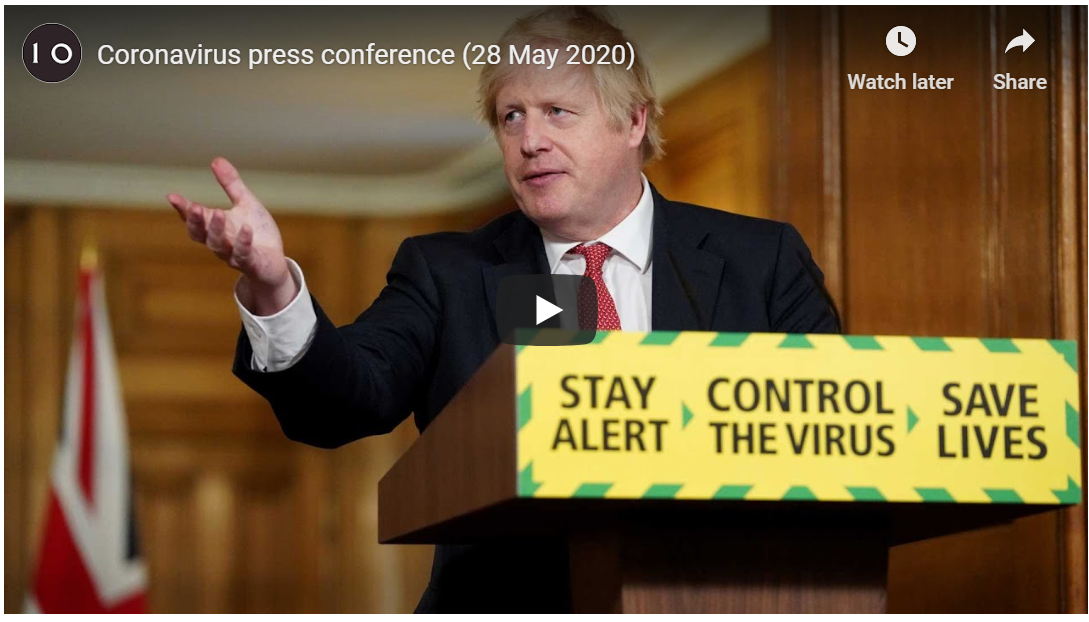I am worried that the UK Government is easing the lockdown too soon, and I am going to continue to be very careful in the coming weeks. Here’s why.
I am not a doctor or an epidemiologist: I’m an economist. That means I don’t know about the biology (but I can read statistics pretty well.) Economists are famously bad at making forecasts, so you would be unwise to take any notice; but I predict that we will look back on this period as a major policy error by the UK government (sadly not the only such mistake). I hope I am wrong.
There are three reasons I am worried.
First, the rate of infection in the UK is high. Note, this is not the same as the reproduction number, or R – we come to that next. The Government has focused a lot on R, and not enough on the infection rate. About 0.27% of the population (outside hospitals and care homes), or about 150,000 people, are infected in the UK according to a survey conducted by the Office of National Statistics between 27 April and 10 May 2020 (95% confidence interval: 0.17% to 0.41%). (The rate in hospitals and care homes is likely to be even higher.) That is one in 400 people outside hospitals. If that doesn’t sound very many to you, consider that (a) the upper bound of this estimate, 0.41%, is about one in 250 people; (b) the people that you encounter are substantially more likely than the average person to be infected (because if you encounter them, other people are likely to encounter them too); and (c) the infection rate has probably not fallen much in the last week (see next paragraph). My guess (and it is only a guess) is that as many as 1 in 150 of the people you encounter may currently carry the virus without knowing it.
Second, R is close to 1. According to the government, R was somewhere between 0.7 and 1 before the recent relaxation. I assume that it is higher now, for two reasons. First, anecdotally it looks to me as if people have been far less conscientious in maintaining a physical distance since the behaviour that led to infections on which this estimate is based – in the last few weeks I have seen people meeting in parks, workers close to each other on building sites, crowded buses, busy streets, and so on. Second, since this estimate was made, the government has begun to encourage people to go to work (leading to crowded tubes and trains, for example), and relaxed other restrictions (for example, allowing people to meet people from other households). So if R was around 0.85 two weeks ago, I would be surprised if it is much below one now.
Third, the UK does not yet have capacity to test, trace and isolate if there is an outbreak. In the absence of a vaccine, the only way we can manage this virus is to identify each outbreak the moment it occurs, and to ringfence it. To do this, we need large scale, rapid testing; and a team of contact tracers who can quickly identify the people who need to isolate to prevent further spread. We have neither. If there is a spread of the virus, we are unlikely to detect it, and we do not have the machinery in place to contain it. Without test, track and trace, we should not be considering relaxations that make another outbreak more likely, such as allowing people back to work, or to meet in groups.
Your risk of becoming infected is determined by a combination of the number of people you encounter who carry the virus (which is determined by the infection rate) multiplied by the chance that they pass it on (which is determined by the reproduction number, or R). We need to be sure the infection rate is well down before we allow R to rise. If R creeps back up to 1 now, we may be locking in our infection rate at an unsustainably high level, so putting at risk the lives and health of thousands of people.
I’ve seen a lot of commentary about how Denmark has opened its schools despite having a relatively high R number. That’s true: Denmark’s R number is about 0.9, up from about 0.6 when it relaxed it’s restrictions, including reopening schools. But remember: the risk is the product of the infection rate and the R number. Denmark has a much lower infection rate than the UK – they have just 1,200 cases, which is about 1% of the number of infections in Britain. A total of 543 people have, sadly, died in Denmark since the outbreak began; in Britain, 468 deaths were announced today alone. With infections low, Denmark can allow R to rise a little; the UK cannot.
For these three reasons, I am very sceptical of the Government’s decision to start to relax the lockdown. There is little or no headroom to keep the reproduction number (R) below 1; the infection rate is too high (or at least, we do not yet have evidence that it has come down); and we do not have a mechanism to test, trace and isolate in place.
I fear the government is under pressure from big business to relax the lockdown sooner than is sensible. I think there is a significant risk of an uncontained second wave of infection in the UK. I have a horrible feeling that a key question in a future public inquiry may turn out to be: “why did we relax before the infection rate was properly down, and before we had proper test, trace and isolate in place?” I really, really hope I am wrong.
I realise that I am speaking from a position of great privilege: I have a job which I can do from home, and I am not home-schooling children or caring for anyone else. I can see why many people want this lock-down to end soon. But I would rather that the government supports them in other ways for a few more weeks.
Covid-19 can be a truly horrible infection. It can be fatal; and for those who survive, there may be considerable long-term physical and mental damage. Eager though I am to get out of lock-down, I do not believe it is worth the risk that we may be a few weeks too early. Before relaxing, we need a proper system to test, trace and isolate, and we need evidence that the infection rate is way down (in the hundreds, not the hundreds of thousands). Until then, please be patient.
And once again, I’m an economist, not a public health specialist or an epidemiologist. So I encourage you to treat this analysis with scepticism. But I hope you will try to stay safe for now.


